| |
|
|
| |
|
|
| |
Luftwaffe night fighter control methods. |
|
| |
|
|
| |
Part 3. |
|
| |
|
|
| |
Home |
|
| |
|
|
| |
Back |
|
| |
|
|
| |
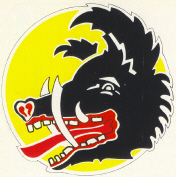 |
|
.jpg)
|
|
| |
|
|
| |
|
|
| |
Wilde Sau. |
|
| |
|
|
| |
3. Wilde Sau was implemented. This was a target defence concept based on single
engine fighters visually acquiring the bombers, either by their shadow on the clouds illuminated from below by the burning city or by the Flak searchlights. Wilde Sau has been described as innovated after the fire storm attack on Hamburg, but in
fact experiments had been carried out in the Ruhr area 3 weeks prior. The "conceiver" Col H. Hermann had approached Gen. Kammhuber with an implementation proposal, but had been turned down. After Hamburg every measure promising success had to be tried.
A new Jagddivision (30 JD) with JG 300, 301 and 302 was formed subordinated directly to
Lw.Befh.Mitte (the later Lft.Reich). Attached to 30 JD was also III/KG 3 (Behelfsbeleutchtergruppe with 1 - 3 Beh.Bel.St.) who was tasked to fly
above the Bomber Stream and illuminate it with flares, in order to facilitate interception and acquisition by the Wilde Sau pilots. In order to give the pilots some measure of situational awareness, the Grossraumlage was broadcast from JK
and JD Gef.Stds. (Reportage).
At the end of 1944 Wilde Sau was re-named
Objekt Nachtjagd. |
|
| |
|
|
| |
|
|
| |
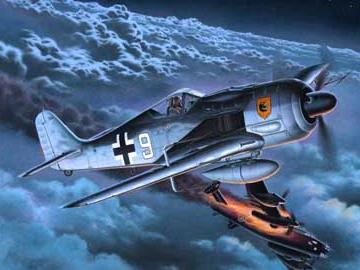 |
|
| |
A Fw 190 A-7/R-11. |
|
| |
|
|
| |
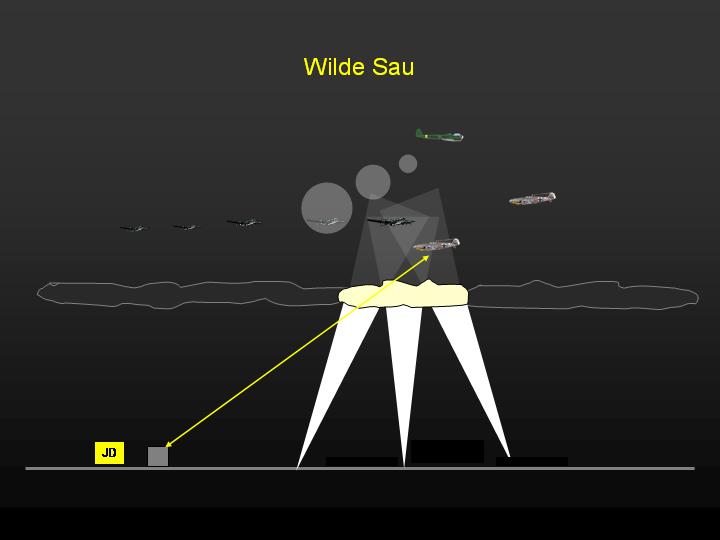 |
|
| |
|
|
| |
The Bf 109 and the Fw 190 were not very well equipped with radio aids to navigation - to put it mildly.
And in a single seat fighter the pilot must perform the navigation himself. Accordingly a very elaborate system of visual aids to navigation were established, encompassing light beacons, searchlight patterns, Flak firing combinations of various tracer
colors through the clouds and parachute flares. The map below is based on a German original from the winter 1943 - 44, and depicts the aids established in the area within 150 km of Bonn-Hangelar.
Further so called Leuchtstrasse (illuminated alleys) were established to
facilitate navigation between key airfields. Please see map below. |
|
| |
|
|
| |
Wilde Sau Karte. |
|
| |
|
|
|
|
Map of
Leuchtstrassen. |
|
|
|
|
|
|
|
Leuchtfeuer. |
|
|
|
|
|
| |
Zahme Sau. |
|
| |
|
|
| |
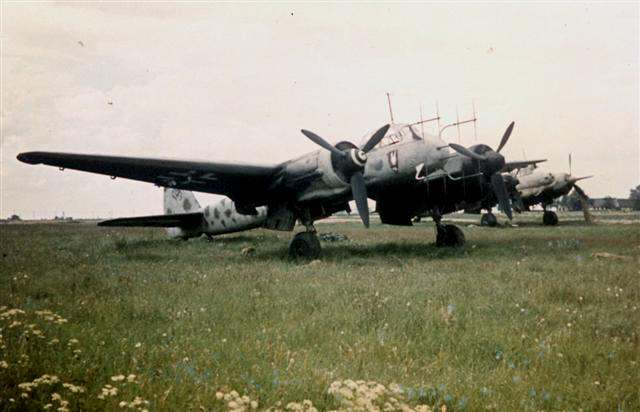 |
|
| |
One of the mainstays of Zahme Sau, a Ju 88 C from II/NJG 102 at
Kastrup, May 1945.
Mr. J. Junker (©), with his kind permission. |
|
| |
|
|
| |
4. Zahme Sau was implemented.
In essence this was nothing but
Y-Verfahren at night. The Hauptlage
was presented as previously described in the JD GefStd. Based on
Lft.Reich assessment of where the Bomber Stream would penetrate, the JDs were
ordered to scramble a large number of night fighters, which were to orbit
navigation beacons along the route assessed to be followed by the bombers.
Once the track of the Bomber Stream had been established, fighters would be
ordered to leave the beacon and initiate an intercept. The first
fighter would be tracked and controlled via one Y-Bodenstellung in a
Y-Stellung, until it was established on an intercept vector, and a new
fighter would go through the same procedure. Up to 3 fighters could be
tracked by 1 Y-Bodenstellung and 1 JLO. This gave a Y-Stellung the and
5 JLOs the theoretical ability to control 15 night fighters at a time.
GYGES had 18 JLO positions thus given it a theoretical control capacity of
54 fighters. This method of control was named Geführte Zahme Sau. The Luftwaffe fully realized the inherent delay in the
production of the Hauptluftlage, and in order to overcome this, the
Fühlungshalter CONOPS was introduced. 4 Luftbeobachtungs Staffel (L.Beo.St. 1, 2, 3 and 7) were established.
These aircraft had the callsign BEPPO. Aircraft from these units were scrambled very early, in order to intercept
the lead bombers in the Bomber Stream. Having done so, they would
shadow the lead aircraft, and be tracked via their FuG 25 by a Freya
EGON. This would give the JD a fairly accurate position of the point
of the Bomber Stream. |
|
| |
|
|
| |
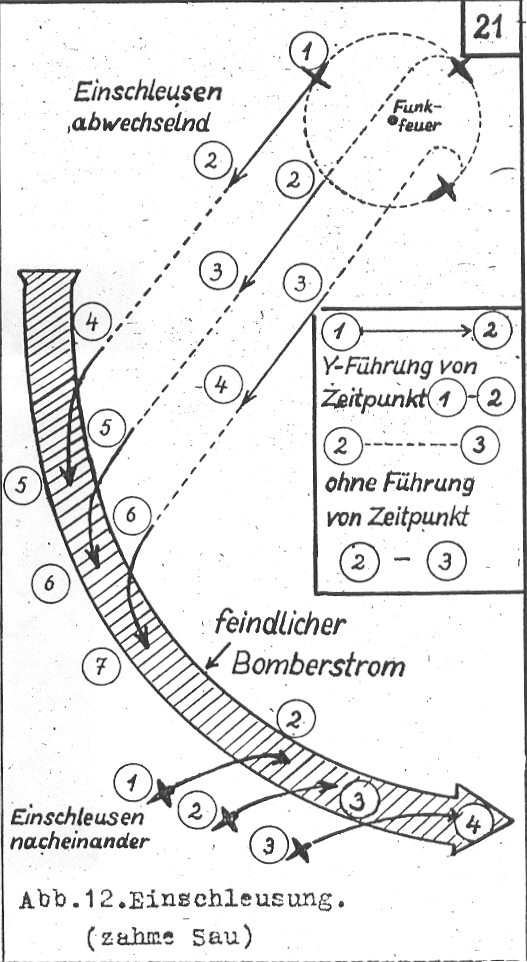
|
|
| |
A much published illustration depicting
the above control method. ("Das
Y-Verfahren (Jagd)"). |
|
| |
|
|
| |
|
|
| |
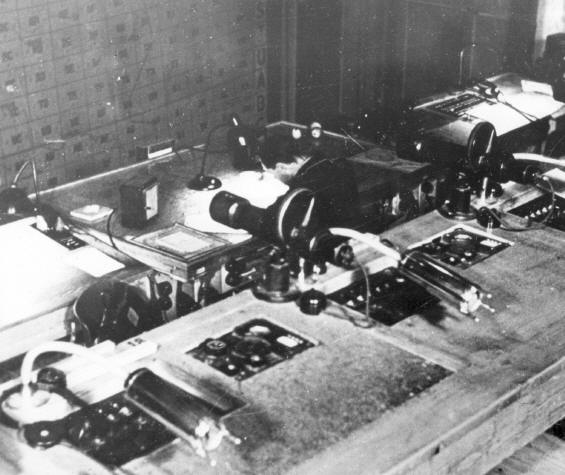
|
|
| |
2 JLO positions
in SOKRATES, note Hauptlage-Karte in the background. Author
collection. |
|
| |
|
|
| |
|
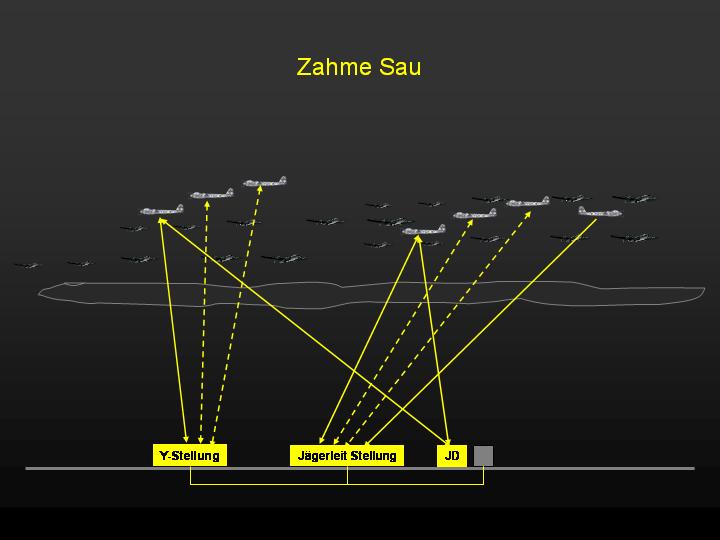
|
| |
| |
Once the Wilde and Zahme Sau had been appreciated by the RAF, a number of
countermeasures were implemented. Wilde Sau depended on Lft.Reich
ability to timely establish the indented target. The RAF response was
to conduct a number of small decoy raids against a number of towns, which
coincided with the arrival of the Bomber Stream over the real target.
This obscured the production of the Hauptlage, the result could be that
Wilde Sau fighters were ordered to the wrong target area. It
also left the control officer in a dilemma. The decoy aircraft dropped
markers AND bombs. If the control officer ignored the decoys, and left the
town undefended, he could very well face the wrath of the population and his
superiors. |
|
| |
Frequently a very elaborate diversionary
raid was flown concurrent with the penetration of the Main Bomber Stream.
The intention was to deceive Lft.Reich to scramble the fighters to the wrong
area. At this time there was no fixed relationship between the JD and the
subordinate units. Lft.Reich would order a JD to scramble the fighters and
hand over control to the JD in whose area the Bomber Stream was
penetrating. A judgment, which again was a work of art. |
|
| |
|
|
| |
For a more
detailed account of the first month of operation under the new CONOPS please see:
Part 9. |
|
| |
|
|
| |
|
|
| |
RAF counter measures. |
|
| |
|
|
| |
The RAF response to Wilde and Zahme Sau followed several avenues of
approach: |
|
| |
|
|
| |
COMPLICATING
THE PRODUCTION OF A RECOGNIZED AIR PICTURE (Luftlage). |
|
| |
a. Use of Chaff to deny
target acquisition, use of Stand Off jamming to hide the approach of the
Bomber Stream and Escort jamming against search radars (Freya, Wassermann
and Mammut) once the defended area had been penetrated. |
|
| |
|
|
| |
b. Use of Stand-Off
jammers in an area far away from where the Bomber Stream was planned to
penetrate. The jamming started at the same time as the jamming
supporting the main effort. Lft.Reich was now faced with two jamming
screens, but it was not yet possible to actually detect the bombers.
The controller had to delay scramble until the system had established the
where The Stream was penetrating. |
|
| |
|
|
| |
c. A decoy Bomber
Stream. Concurrent with the approach of the real Stream, a diversion,
using a limited number of bombers, but with full Chaff support and
electronic jamming, would be mounted in an area far away from the real
effort. |
|
| |
|
|
| |
The above measures were intended
to: 1. Delay the time at which the Luftwaffe fighters were scrambled.
2. Hopefully deceive the controller to scramble to the wrong area.
3. Protect the bombers from detection, tracking and interception. |
|
| |
|
|
| |
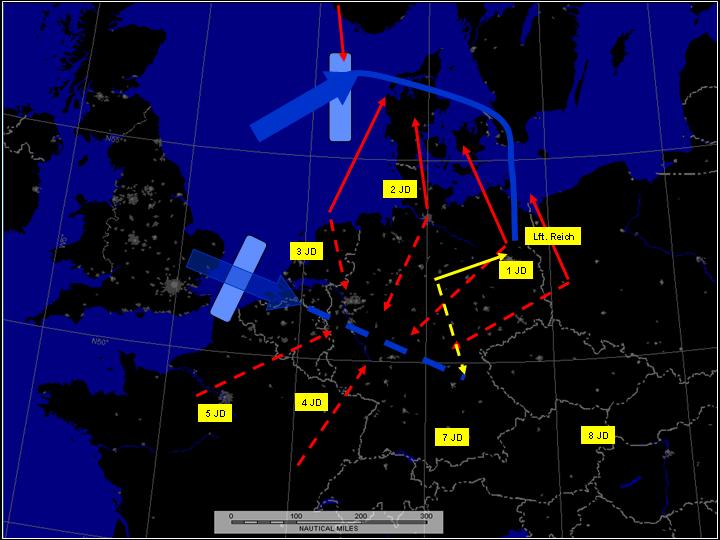
|
|
| |
The above map illustrates the
principle of the RAF deception scheme. The real Stream is approaching
across The North Sea protected by Stand-Off jammers some way off the coast.
A decoy stream has just penetrated over The Netherlands also protected by
jammers. At the time the jamming was started, before the Stream could
be acquired, the controller at Lft.Reich would start the evaluation process. At this point the codeword "Zugvogel" would be issued to the JDs indicating impending action, but a unresolved situation. The Northern Stream indicates a penetration
against Central Germany, the Southern one a penetration towards Southern Germany. If the weather in both areas is suitable for Ground Marking, a penetration into either area is likely. When the aircraft in the Streams "burns-through" the jamming, the
controller is faced with two Streams, which still have a great "look-alike". The longer he delays the scramble the fewer fighters can be employed. Conversely if he misidentifies the real Stream and decides to scramble, the Zahme Sau (red arrows) will
ordered to beacons located in areas too far away from the real Stream (dotted arrows), and it will be doubtful if they can reverse course and reach the real Stream before the attack unfolds. The Wilde Sau (yellow arrows) will simply be ordered to the wrong
target, and due to their short endurance this disposition is in most cases irreversible. The decoy stream would frequently turn back after a shallow penetration in order to avoid losses. At this time all doubt about the real Stream was dispelled.
The codeword "Adler" would be issued to the JDs, indicating that the main thrust had been identified. If more than one Bomber Stream was identified they would be given color codes. |
|
| |
|
|
| |
|
|
| |
COMPLICATING THE IDENTIFICATION
OF THE TARGET. |
|
| |
a. A small
number of aircraft would penetrate along with the Stream and fan-out
against a number of cities. |
|
| |
|
|
| |
b. A small decoy
force would fly in front of the Stream, pass the actual target and proceed
towards another very likely target area. Concurrent with the decoy force
arriving at their objective, the Stream would open the attack on the real
target. |
|
| |
|
|
| |
The above measures were intended
to: Deceive the controller into directing the Wilde Sau units to the wrong
target and scramble the Zahme Sau unit to beacons so far away from the
Stream, so it would be difficult to intercept prior to the Stream reaching
the target. |
|
| |
|
|
| |
DEFENSIVE AND OFFENSIVE USE OF
FIGHTERS. |
|
| |
a. Allied night fighters
would escort the Stream and attempt to intercept incoming German night
fighters. The RAF night fighters had been equipped with the Perfectos
equipment, which could interrogate the Luftwaffe IFF FuG 25. An
incoming German fighter could thus be detected and identified up to 50 miles
away. The RAF fighters were further equipped to home on Lichtenstein
emissions (Serrate). |
|
| |
|
|
| |
b. MAHMOUD PATROLS. A number of
allied fighters would be sent to orbit the beacons most likely to be used
for marshalling Zahme Sau fighters constituting a most "annoying" welcome
committee. |
|
| |
|
|
| |
c. FLOWER PATROLS. Allied fighters (Intruders) would attack German night fighter air fields thus disrupting operation, and they would patrol in the vicinity of the air fields in an attempt to engage
aircraft taking off or landing. |
|
| |
|
|
| |
The above measures were intended
to: Intercept German night fighters before they could "infiltrate" the
Stream, disrupt scramble and recovery of night fighters. The tactical
effect in terms of German night fighters shot down might have been minimal,
but the operational level effect was enormous. In order to avoid
detection by Perfectos the night fighter crews switched of their IFF, which
made it impossible to track them by Freya EGON. The allied activity
against and around German airfields forced the Luftwaffe to apply a
wide range of active and passive defensive measures. Runway and
approach lights were only switched on during the night fighters final
approach, when the night fighter crew started their homeward flight they
frequently chose to do so at low level, in weather, in hilly terrain.
This made it almost impossible to use navigation aids, and the Newton Factor
(controlled flight into terrain) increased tremendously. Not until the
fighters were safely parked back at the dispersal and the crew had taken shelter could
they fell safe. |
|
| |
|
|
| |
MEASURES AIMED AT FRUSTRATING
FIGHTER CONTROL. |
|
| |
|
|
| |
a. Jamming was employed
against the frequencies (38
- 42 Mhz) used for Y-Verfahren. Initially
by spot jammers, but from mid 1944 by board band jammers, that that could
take out the entire frequency band. |
|
| |
|
|
| |
b. Employment of Chaff, which
was effective against Würzburg-Riese and Lichtenstein. |
|
| |
|
|
| |
The above measures were intended
to: Frustrate effective Zahme Sau employment, prevent Himmelbett-Verfahren
and make it difficult to use the Lichtenstein for target acquisition.
It should be recalled that the Hauptluftlage did not provide for accurate
fighter control. The difference between the plot of the point of the
Bomber Stream or a single track easily could differ with as much as 20 miles
from the actual position. This made control against single targets an
illusion, but the Bomber Stream would extend over maybe 200 miles, so as
soon as the track had been established, Y-Verfahren could be employed to
direct the fighters into the Stream. The ability to do target
acquisition, however, depended on the night fighter crew's ability to use
the Lichtenstein. |
|
| |
|
|
| |
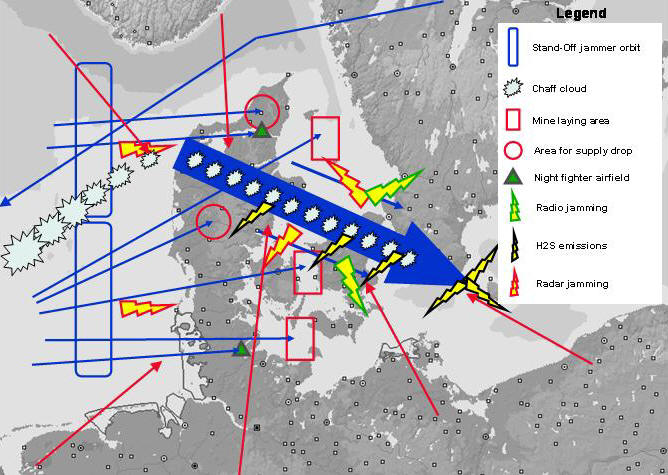
|
|
| |
An air defence
controllers nightmare. A graphic presentation of the above
lengthily verbal description. Whenever a Stream was penetrating mine
laying and supply drops to the resistance movement was also conducted.
The blue track North of Denmark represents a courier flight from Sweden to
the UK. The red arrows illustrate Zahme Sau fighters closing from
neighboring divisions.
I have used some
time and space describing RAF operations and CONOPS. I think that
without this, it is impossible to understand the Luftwaffe defensive
organization, tactics and procedures and the subsequent development, which
will be described in part 4. |
|
| |
|
|
|
|
| |
The above description is based
on allied and German documents (list
of some Luftwaffe documents in
Bundesarchiv) and the three excellent, highly recommendable books: |
|
| |
|
|
| |
"Instruments of Darkness",
A. Price, Macdonald and Jane's Publishers Limited, London 1977. An
absolute classic on the subject. |
|
| |
|
|
| |
"Confound and destroy", M.
Streetly, Macdonald and Jane's Publishers Limited, London 1978. |
|
| |
|
|
| |
"Most Secret War", R.V.
Jones, Hamish Hamilton Ltd, London 1978. An absolute "must read" for
any serious student of this subject. If you are not a serious student,
but want a good laugh or entertainment on par with Tom Clancy, this is it -
and it's a true story. |
|
| |
|
|
| |
|
|
| |
The reader may also want to visit
this site on the official history of RAF Bomber Command.
|
|
| |
RAF History - Bomber Command 60th Anniversary |
|
| |
|
|
| |
|
|
| |
|
|
| |
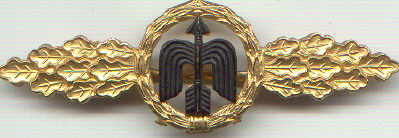 |
|
| |
|
|
| |
|
|
| |
Back |
|
| |
|
|
| |
Home |
|
| |
|
|
| |
|
|
| |
|
|

.jpg)








![]()